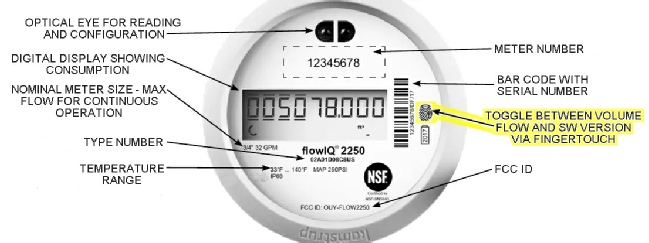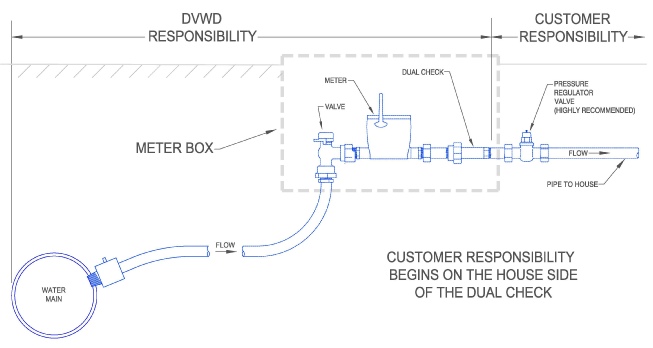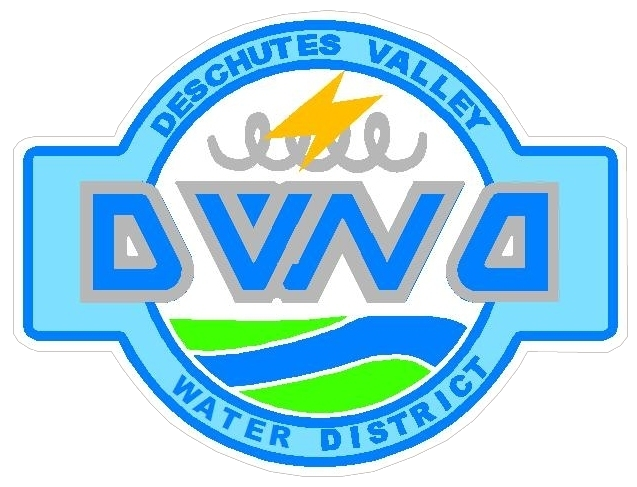
All services in the District now have radio read “smart” meters. The District started retrofitting services beginning in 2020 and all new service installations are fitted with this meter. The brand and type our District uses is the KAMSTRUP flowIQ 2250.
Below are some steps for you to take to familiarize yourself with your water meter, and possibly troubleshoot finding a leak without having to call a plumber.
- Turn off all the water in your home. This includes all faucets, dishwasher, irrigation, etc.
- Locate your meter box & lift the lid. (If you cannot locate your meter, our office can give you a rough idea). Meters are usually next to the driveway along the street or road, but not always. You may need a flashlight to see inside the meter box.
- Using a clean paper towel or rag, clean off the face of the register.
- On the right side of the face of the register is a small thumbprint (to the right of the UPC bar code). This is the display TOGGLE, highlighted below in yellow.

- Press the “fingerprint” until you see a number in the register– with GPM in small letters below it. This is the Gallons Per Minute going through your meter. If you have all the water off in your house, and there is water still registering on the GPM display, you have a leak.
- The GPM is highlighted in red in the picture below. Note the swirling arrows on the bottom left of the display. This indicates there is water actively flowing through the meter.

Do you have a water leak?
The most common cause of leaks are toilets, which can account for 30% of your water use.
Have you heard the water running to your toilet even when not in use? To test for toilet leaks, add a few drops of food coloring, or some powdered (colored) drink mix to the tank.
Wait an hour and check the bowl. If color is showing up in the bowl, you have a leak allowing water to flow from the tank to your drain without ever flushing the bowl. Often this can be remedied by replacing the flapper gasket or the entire assembly, which can be found at most hardware stores.
Other common leaks include frost-free standpipes and irrigation lines. Keep in mind, you can’t always see where a leak is outside. Leaks don’t always cause wet spots or mud puddles. We live in basalt country where a tiny crack in the bedrock basalt can quickly drain away excess water from a leaky pipe, leaving now visible trace.
If you have a water shut-off valve going into your house (or under your house), shut this off and re-check the meter. If the leak is still registering, your leak is underground between the house and meter. Isolating the leak is essential to fixing it.
Once you think you’ve found and fixed the leak, consult your meter again to confirm the GPM registers “0”.
Our service staff can come out to your property and give you pointers & answer questions that you may have. Every property is different, and there may be some likely culprits–but our staff cannot fix any leaks nor can lthey ocate the water lines on the customer’s side of the meter. A service call for a leak consultation will result in a $25 charge on your next water bill.
For more in depth information on the meter serving your property, a user guide can be found online here. We also have additional tips for finding water leaks here.
DVWD vs CUSTOMER RESPONSIBILITY
The District is responsible for your water line up to and including the dual check on the house side of the meter. Anything further toward the house is the homeowner’s responsibility to fix. Below is a diagram showing where District responsibility ends and the homeowner responsibility begins.

